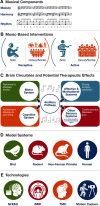Music and Brain Circuitry: Strategies for Strengthening Evidence-Based Research for Music-Based Interventions
- PMID: 36351825
- PMCID: PMC9665917
- DOI: 10.1523/JNEUROSCI.1135-22.2022
Music and Brain Circuitry: Strategies for Strengthening Evidence-Based Research for Music-Based Interventions
Abstract
The neuroscience of music and music-based interventions (MBIs) is a fascinating but challenging research field. While music is a ubiquitous component of every human society, MBIs may encompass listening to music, performing music, music-based movement, undergoing music education and training, or receiving treatment from music therapists. Unraveling the brain circuits activated and influenced by MBIs may help us gain better understanding of the therapeutic and educational values of MBIs by gathering strong research evidence. However, the complexity and variety of MBIs impose unique research challenges. This article reviews the recent endeavor led by the National Institutes of Health to support evidence-based research of MBIs and their impact on health and diseases. It also highlights fundamental challenges and strategies of MBI research with emphases on the utilization of animal models, human brain imaging and stimulation technologies, behavior and motion capturing tools, and computational approaches. It concludes with suggestions of basic requirements when studying MBIs and promising future directions to further strengthen evidence-based research on MBIs in connections with brain circuitry.SIGNIFICANCE STATEMENT Music and music-based interventions (MBI) engage a wide range of brain circuits and hold promising therapeutic potentials for a variety of health conditions. Comparative studies using animal models have helped in uncovering brain circuit activities involved in rhythm perception, while human imaging, brain stimulation, and motion capture technologies have enabled neural circuit analysis underlying the effects of MBIs on motor, affective/reward, and cognitive function. Combining computational analysis, such as prediction method, with mechanistic studies in animal models and humans may unravel the complexity of MBIs and their effects on health and disease.
Keywords: brain circuits; music-based interventions; musical components; technologies; therapeutic effects.
Copyright © 2022 the authors.
Figures

